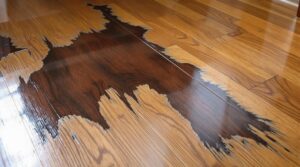Filing water damaged carpet insurance claims requires methodical documentation and prompt action. Property owners must first photograph all damage extensively before cleanup, locate and stop the water source, and immediately contact their insurance provider. A detailed written report noting dates, times, and the water source origin should accompany all visual evidence. Working with insurance adjusters demands organized documentation and professional damage assessments. Understanding the complete claims process guarantees ideal settlement outcomes.
Key Takeaways
- Document the water damage immediately with clear photos and videos, noting the date, time, and source of water before cleanup begins.
- Contact your insurance company promptly to report the incident and verify your policy coverage for carpet water damage.
- Create a detailed inventory of all affected areas, including written descriptions and measurements of damaged carpeting.
- Obtain professional estimates for carpet repair or replacement before the insurance adjuster's visit to support your claim.
- Maintain thorough records of all communications with insurance representatives and keep receipts for any immediate remediation expenses.
Understanding Your Insurance Coverage for Carpet Damage
When filing an insurance claim for water-damaged carpet, understanding the specific coverage provided by one's policy serves as the foundation for a successful claim. Homeowners insurance typically covers sudden and accidental water damage, such as burst pipes or appliance malfunctions, while excluding damage from floods, gradual seepage, or maintenance-related issues.
Insurance policies establish coverage limits and specific conditions under which carpet damage claims will be honored. Common covered perils include storms, fires, and accidental impacts.
However, claim denials often occur when damage results from normal wear and tear, pet-related incidents, or floods, which require separate insurance coverage. For renters, it is crucial to note that while personal property is protected under their policy, structural elements like carpeting fall under the landlord's insurance coverage.
Understanding these distinctions helps policyholders navigate the claims process effectively and avoid potential complications during the assessment and settlement phases.
Documenting the Water Damage Scene

Proper documentation of water-damaged carpet begins with extensive photographic evidence taken before any cleanup efforts commence.
Insurance adjusters require clear, well-lit images that capture the full scope of carpet damage, including close-up shots of stains, warping, and affected baseboards.
A detailed written report should accompany the photos, noting the date and time of discovery, the suspected water source, and specific measurements of the impacted carpet areas.
Take Photos Before Cleanup
Thorough photo documentation serves as crucial evidence when filing water damage insurance claims for carpets. Prior to initiating cleanup efforts, homeowners should systematically capture wide-angle photographs of all affected areas, ensuring proper photo organization and damage categorization.
These shots should encompass the entire room, showing the full scope of carpet damage from multiple angles.
Close-up photographs must detail specific areas of water-damaged carpeting, including discoloration, warping, and any visible mold growth. It is essential to document the source of water damage, whether it stems from burst pipes, roof leaks, or flooding.
Additionally, video documentation can provide extensive evidence, offering a walkthrough of the affected spaces while highlighting the extent of carpet damage. All visual evidence should be properly timestamped and stored digitally for submission to insurance providers.
Create Detailed Damage Reports
Documenting water damage through detailed reports forms the cornerstone of a successful insurance claim. Property owners must create extensive records that include incident details, affected areas, and the extent of carpet damage.
The damage assessment should encompass timestamps, photographs, and professional evaluations to establish a clear timeline and scope of the destruction.
Effective claim documentation requires systematic organization of all evidence, including detailed inventories of damaged items, cost estimates, and any relevant correspondence with professionals.
Property owners should maintain consistent records throughout the restoration process, preserving evidence until reviewed by insurance adjusters.
Regular updates to the documentation, combined with clear communication with the insurance company, help guarantee a thorough and well-supported claim that accurately reflects the full extent of carpet damage.
Steps to Take Before Filing Your Claim
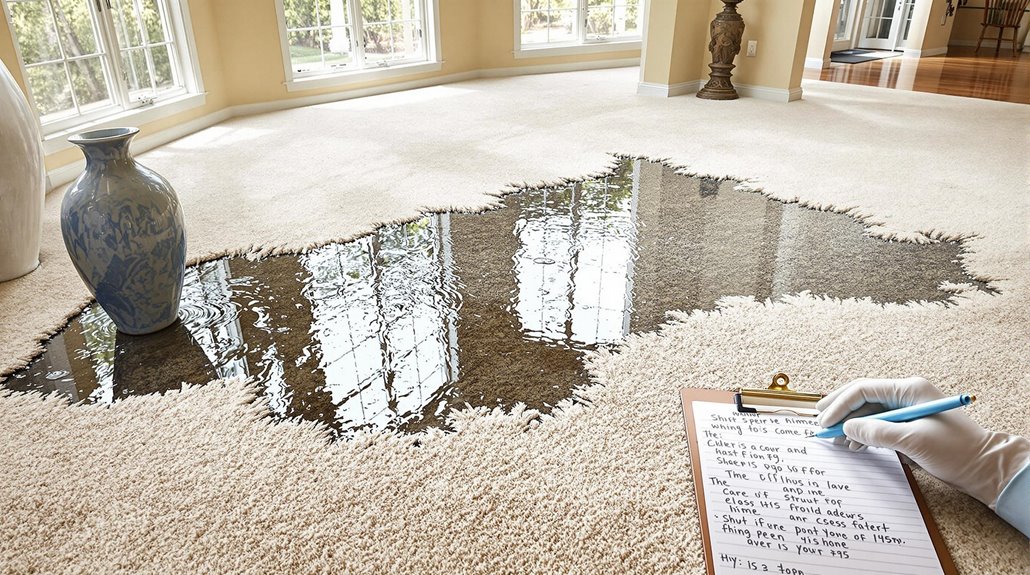
Before initiating an insurance claim for water-damaged carpet, property owners must thoroughly document all visible damage through detailed photographs and written descriptions of affected areas.
Immediately locating and stopping the water source prevents further damage and demonstrates responsible mitigation efforts to the insurance provider.
The next critical step involves promptly contacting the insurance company to report the incident and confirm coverage details before proceeding with any major repairs or restoration work.
Document All Visible Damage
Proper documentation of visible water damage serves as vital evidence when filing an insurance claim for damaged carpeting. The damage assessment process should begin with thorough photography and video documentation of all affected carpet areas from multiple angles, capturing the extent of water infiltration before any cleanup efforts commence.
Evidence preservation is fundamental during this phase, requiring detailed images of both structural impacts and specific damage patterns in the carpeting.
A thorough inventory of affected areas should be created, organized by room, with detailed descriptions of the carpet condition, including age, original value, and pre-damage state.
All documentation, including communication records with insurance representatives and contractors, must be maintained securely. This systematic approach guarantees a complete record for the insurance adjuster's evaluation and supports a thorough claim submission.
Stop Water Source Immediately
Swift action to halt the water source stands as the vital first step before initiating an insurance claim for carpet damage. When water damage occurs, immediate safety measures and quick response can greatly minimize the extent of destruction and subsequent claim costs.
| Emergency Action | Implementation Steps |
|---|---|
| Main Valve | Locate and shut off immediately |
| Source Location | Identify leak origin and type |
| Safety Checks | Turn off electricity to affected areas |
| Emergency Plumbing | Contact 24-hour service if needed |
| Contamination Check | Determine if water is clean or contaminated |
Property owners must first guarantee their safety by turning off electricity to affected areas before addressing the water source. Whether dealing with a burst pipe or flooding, identifying the water source type helps determine appropriate emergency plumbing solutions. If the situation exceeds basic control measures, contacting professional emergency services becomes essential for proper mitigation.
Contact Insurance Provider First
After securing the water source, property owners must initiate immediate contact with their insurance provider to establish a valid claim for water-damaged carpets.
The claims notification process requires thorough documentation of the damage through dated photographs and videos from multiple angles, showing both affected carpet areas and undamaged sections for comparison.
Property owners should utilize their insurance provider's mobile apps or online platforms for swift claim submission, ensuring all initial evidence is properly uploaded.
During this initial contact, it's essential to review insurance policy terms, understand coverage limits, and confirm applicable deductibles.
Maintaining detailed records of all communications with the insurance company, including timestamps and conversation summaries, strengthens the claim's documentation trail and facilitates smoother processing of carpet damage claims.
Gathering Essential Evidence and Paperwork
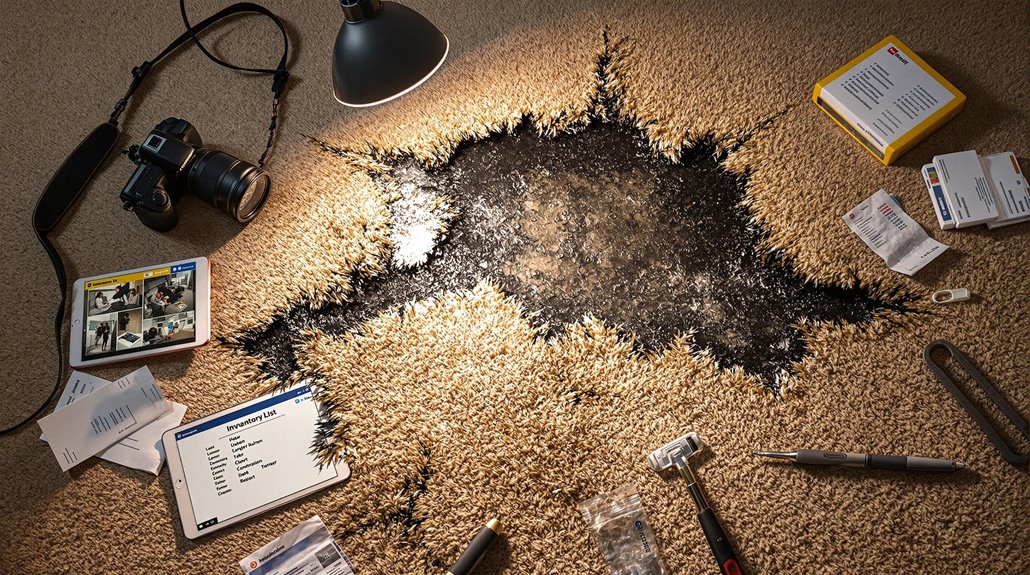
Documenting water damage thoroughly with essential evidence and paperwork forms the foundation of a successful insurance claim. Property owners must systematically gather extensive photographic and video evidence of the affected carpet areas, ensuring both wide-angle and detailed close-up shots that clearly demonstrate the extent of the damage.
Evidence preservation requires capturing well-lit images from multiple angles, documenting the water source, and securely storing all digital files.
Proper inventory management involves creating a detailed list of damaged items, including the carpet's pre-damage condition, replacement costs, and overall value assessment. Property owners should maintain all original receipts for temporary repairs and related expenses.
A thorough incident report must be prepared, noting the date, time, and cause of the water damage, along with immediate actions taken.
This documentation, combined with supporting photos and inventory lists, creates a complete evidence package for the insurance claim process.
Working With Insurance Adjusters
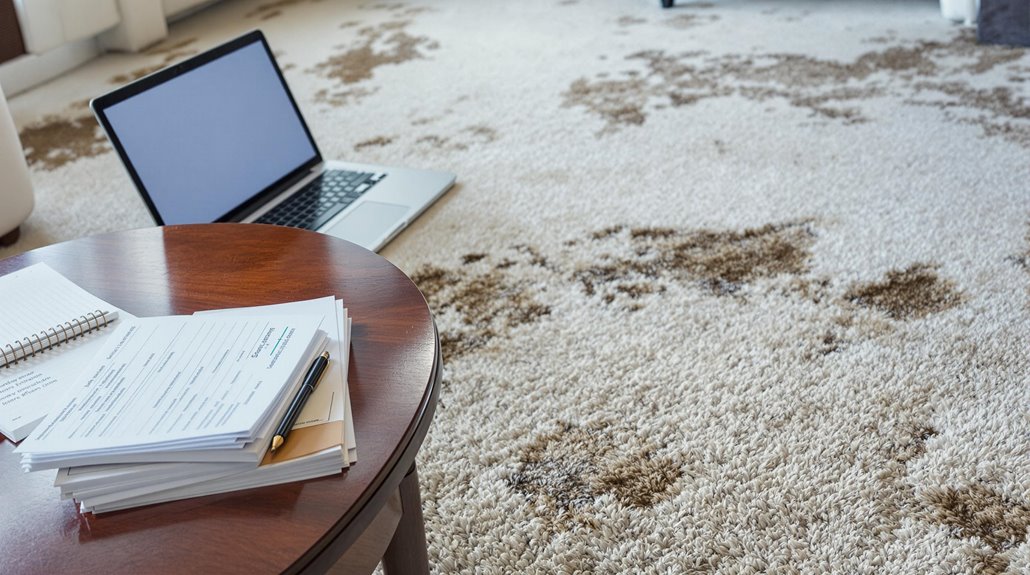
Successfully managing a water-damaged carpet insurance claim requires effective collaboration with insurance adjusters who serve as critical intermediaries between policyholders and insurance companies. Homeowners must understand that adjusters work for the insurance provider and aim to minimize payouts while guaranteeing fair claim resolution.
Effective adjuster communication begins with thorough preparation before their visit. Homeowners should compile detailed documentation, including photographs, videos, and detailed inventories of carpet damage.
During the inspection, walking the adjuster through affected areas while highlighting documented damage helps guarantee accurate assessment.
Negotiation strategies involve maintaining persistent yet professional dialogue while presenting multiple repair estimates to support the claimed amount. Policyholders should review the adjuster's report carefully, addressing any discrepancies promptly.
Understanding policy coverage limitations and maintaining detailed records of all interactions strengthens the negotiating position. If disputes arise regarding damage extent or repair costs, homeowners may need to seek professional assistance to achieve fair compensation.
Common Causes of Water Damage That Qualify
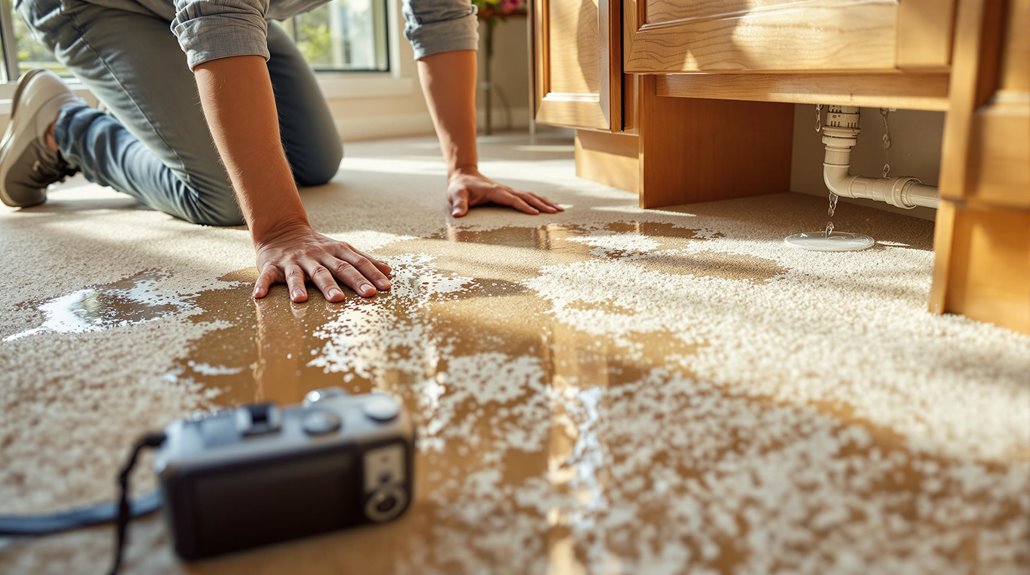
Understanding water damage causes that qualify for insurance coverage requires careful classification of incidents based on contamination levels and origin sources. Most insurance policies categorize water damage events by the type of water involved and the nature of the incident.
| Damage Type | Common Qualifying Causes |
|---|---|
| Clean Water | Burst pipes, appliance malfunctions |
| Grey Water | Dishwasher leaks, washing machine overflow |
| Black Water | Sewer backups, septic overflows |
| Gradual | Hidden leaks, foundation seepage |
Insurance policies typically cover sudden and accidental water damage from sources like burst pipes, appliance malfunctions, and certain types of flooding. However, coverage may vary depending on the contamination level. While clean water damage from burst pipes often qualifies for coverage, black water damage from sewage backups might require additional endorsements. Gradual damage from hidden leaks may qualify if the homeowner can demonstrate the damage was undetectable and reported promptly upon discovery.
Navigating the Claims Process Successfully

Once water damage has been identified as qualifying for coverage, property owners must follow a systematic approach to file and process their carpet insurance claims. Success hinges on adhering to claim timelines and thoroughly documenting all damage through photographs, videos, and detailed inventories.
Property owners should immediately contact their insurer and review policy comparisons to understand specific coverage details for carpet damage. During this process, they must preserve the damaged areas and retain any malfunctioning equipment that caused the incident.
Professional estimates for repairs or replacement should be obtained before the adjuster's visit. Throughout the claims process, maintaining detailed records of all communications with the insurance company is essential.
If disputes arise regarding settlement amounts, property owners may consider engaging a public adjuster to advocate on their behalf. Following the adjuster's inspection, claimants should actively participate in discussions about restoration options to guarantee appropriate compensation for their damaged carpets.
Replacement vs. Restoration Options
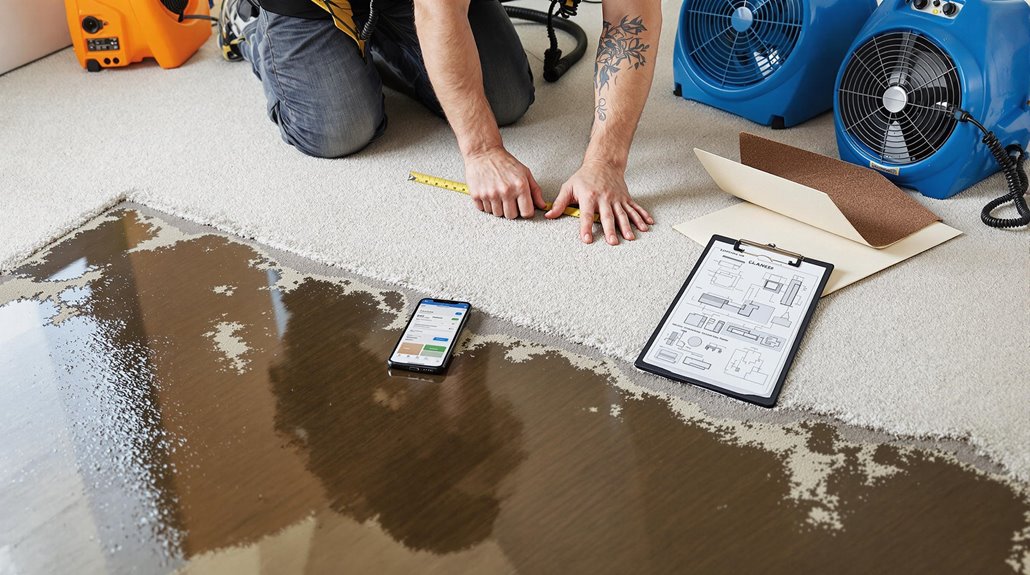
When water damage occurs to carpeting, property owners face a vital decision between replacement and restoration options, each carrying distinct implications for insurance claims. The choice depends on multiple factors, including damage severity, water contamination levels, and economic considerations.
| Factor | Replacement Advantages | Restoration Challenges |
|---|---|---|
| Health & Safety | Eliminates contamination risks | May leave residual bacteria |
| Cost Impact | Clear-cut insurance claims | Variable expenses and outcomes |
| Time Considerations | Immediate resolution | Extended drying processes |
| Long-term Results | Fresh start guaranteed | Success rates vary by damage |
Professional assessment within 24-48 hours is essential for determining the viable path forward. While replacement advantages include complete elimination of health risks and straightforward claims processing, restoration challenges often center around thorough drying and decontamination requirements. Insurance providers typically favor replacement when water contamination is present or when restoration costs approach replacement values. Property owners should document all damage thoroughly and consult with qualified professionals to support their insurance claims.
Tips for a Successful Claim Settlement
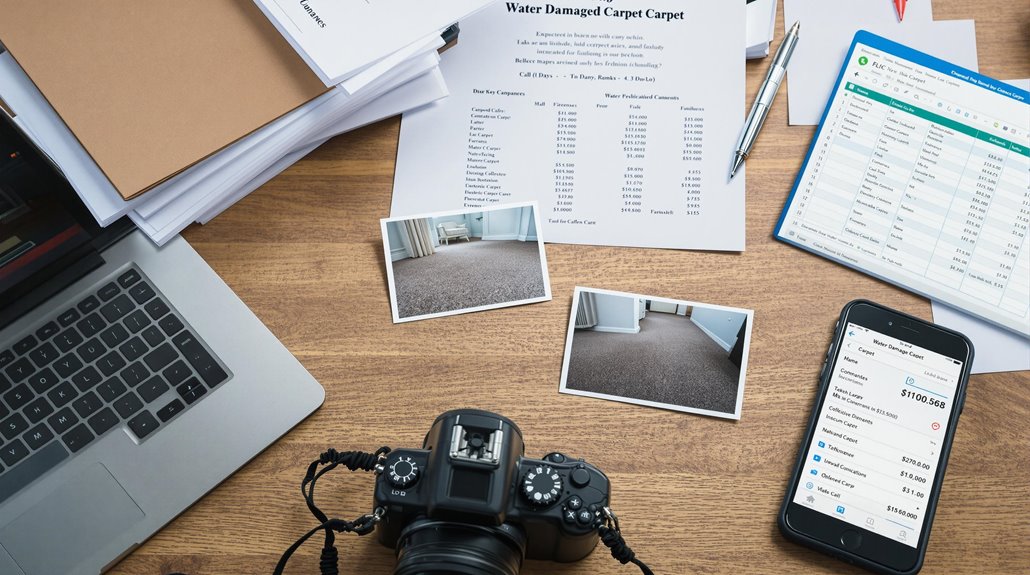
Successful insurance claim settlements for water-damaged carpets rely on a systematic approach to documentation, communication, and negotiation. Claimants should initiate the claim process by immediately removing standing water and photographing all damage before mitigation begins.
Maintaining organized records of all damage-related expenses and communications is vital for evidence collection. Understanding the insurance policy's coverage terms and one's rights under the Unfair Claim Practices Act strengthens the negotiating position.
When interacting with insurance adjusters, claimants should remain factual and avoid speculative statements about the incident. All conversations should be documented in writing, and proof of loss documentation must be submitted within required timeframes.
During negotiations, claimants should avoid accepting initial settlement offers without careful consideration. Counter-offers should be supported by detailed documentation, including contractor estimates and repair costs.
Professional, assertive communication throughout the process helps guarantee fair claim resolution.
The Benefits Of Consulting A Public Adjuster
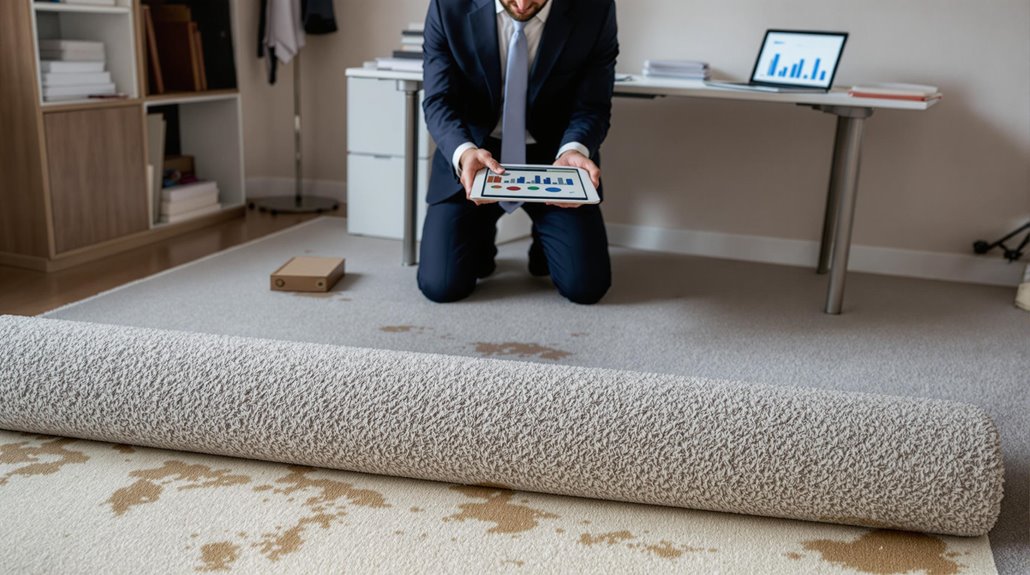
Public adjusters offer specialized expertise in handling water-damaged carpet insurance claims through their objective assessment methods and thorough understanding of insurance policies.
Their involvement streamlines the claims process by managing documentation, communication with insurers, and negotiation of settlements on behalf of policyholders.
Research indicates that claims handled by public adjusters often result in higher settlements due to their ability to identify all compensable damages and effectively advocate for fair compensation.
Expertise In Insurance Claims
Due to the complex nature of water damage claims, consulting a public adjuster offers significant advantages for policyholders seeking fair compensation.
These professionals possess extensive knowledge of insurance policy interpretation and established negotiation strategies, enabling them to effectively advocate for their clients' interests.
Public adjusters demonstrate expertise in managing intricate claims procedures while understanding common tactics insurers employ to minimize settlements.
They utilize industry-standard software and methodologies to prepare detailed damage assessments, ensuring all documentation aligns with insurer requirements.
Their thorough understanding of policy terms and conditions helps identify coverage opportunities that policyholders might otherwise overlook.
Objective Damage Assessment
Among the most valuable benefits of engaging a public adjuster is their ability to conduct detailed, unbiased damage assessments.
Their objective assessment approach guarantees a thorough damage evaluation that identifies all losses, including those that might be overlooked by untrained individuals or insurance company adjusters.
- Guarantees accurate identification and documentation of all water damage to carpeting
- Provides detailed inventory of losses based on industry standards
- Conducts impartial evaluations focused on maximizing policyholder benefits
- Applies expert knowledge to assess both visible and hidden damage
- Delivers thorough documentation to support higher settlement claims
This systematic approach to damage evaluation typically results in settlements three to five times higher than those obtained by policyholders filing claims independently.
Public adjusters' expertise in property loss adjustment guarantees that every aspect of water damage to carpeting is properly documented and valued.
Streamlined Claim Process
When managing the complex process of filing a water-damaged carpet insurance claim, consulting a public adjuster offers considerable advantages through a streamlined and professionally managed approach. Their expertise notably enhances claim efficiency by handling all aspects of documentation, communication, and negotiation with insurance companies.
Public adjusters contribute to paperwork management by meticulously gathering and organizing required documentation, ensuring accurate claim filing, and maintaining adherence to critical deadlines. They simplify the process by assuming responsibility for all negotiations while keeping track of essential timelines.
Their systematic approach includes thorough claim filing, regular communication with insurers, and strategic timeline management. This professional oversight helps eliminate common filing errors and reduces the complexity typically associated with insurance claims, ultimately expediting the settlement process.
Higher Claim Payouts & Settlements
Consulting a public adjuster can substantially increase insurance claim payouts for water-damaged carpets through thorough damage assessment and expert negotiation strategies.
Their professional expertise enables extensive evaluation and documentation of all damages, leading to maximizing settlement potential.
Public adjusters deliver enhanced outcomes through:
- Identification of hidden water damage beneath carpets that might otherwise go unnoticed
- Detailed documentation and evidence gathering to support higher claim values
- Implementation of proven claim negotiation strategies with insurance companies
- Expert interpretation of policy coverage and entitlements
- Strategic advocacy to guarantee full compensation for all legitimate damages
Their specialized knowledge of insurance procedures and regulations, combined with skilled negotiation abilities, helps policyholders secure settlements that accurately reflect the full extent of their carpet damage and necessary restoration costs.
About The Public Claims Adjusters Network (PCAN)
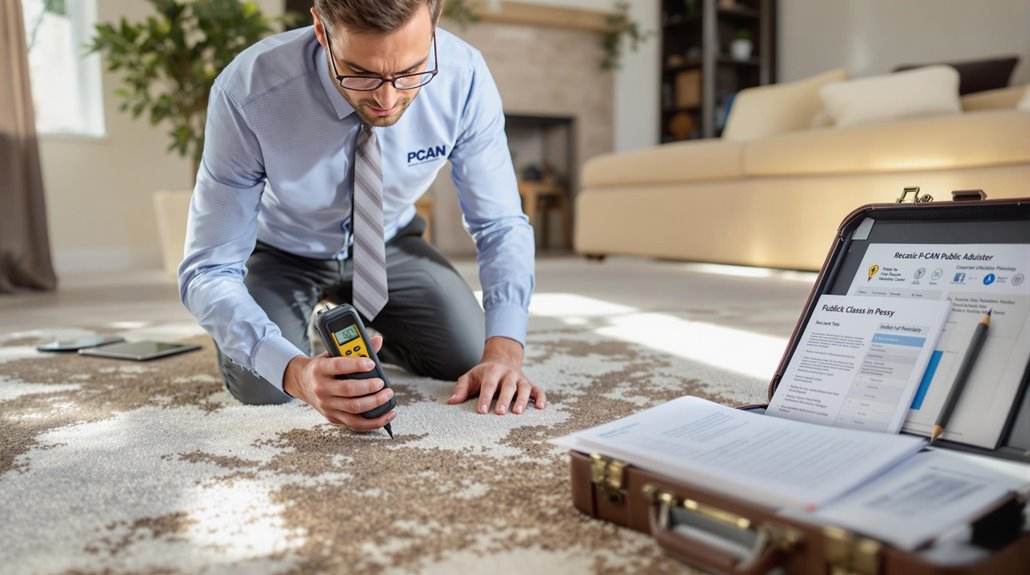
The Public Claims Adjusters Network (PCAN) represents a thorough alliance of independent insurance claims professionals who advocate exclusively for policyholders during the claims process.
Operating across multiple states and internationally, claims adjuster networks like WorldClaim maintain offices on five continents, providing extensive support for both residential and commercial clients.
These networks deliver significant public adjuster benefits through their extensive expertise in policy interpretation, damage assessment, and settlement negotiations.
Organizations like NICA offer specialized claims handling solutions while maintaining strict adherence to state-specific regulations and fee structures.
Their adjusters possess deep knowledge of insurance policies and maintain transparent fee arrangements, which typically range from 10-20% depending on state regulations and claim circumstances.
Through their established systems and professional resources, these networks guarantee policyholders receive expert representation, fair settlements, and efficient claim resolution while steering through complex insurance processes.
Frequently Asked Questions
How Long Does Carpet Mold Typically Take to Develop After Water Damage?
Mold can develop within 24-48 hours after water exposure, necessitating immediate carpet drying techniques and mold prevention strategies. Visible growth appears in 3-12 days under favorable moisture conditions.
Can I Choose My Own Carpet Replacement Brand During Insurance-Covered Repairs?
Like threads in a tapestry, carpet replacement options during insurance claims depend on policy limitations. Insurers typically allow alternative brands if costs remain comparable to their preferred suppliers.
Will My Insurance Rates Increase if I File Multiple Carpet Claims?
Multiple carpet damage claims within three years can considerably impact insurance rates, regardless of damage types. Rate increases typically range from $6-$64 monthly, depending on claim frequency and severity.
Are Oriental or Antique Carpets Covered Differently Than Standard Carpet Installations?
Oriental and antique carpets require specialized coverage beyond standard carpet insurance, often necessitating professional antique carpet appraisal and expert oriental carpet restoration services to determine accurate values and preservation needs.
Does Homeowners Insurance Cover Carpet Damage From Pet Accidents During Water Emergencies?
While 90% of standard homeowners policies exclude direct pet damage, carpet damage during water emergencies may be covered if caused by sudden, accidental events, regardless of pet involvement.





